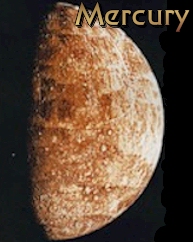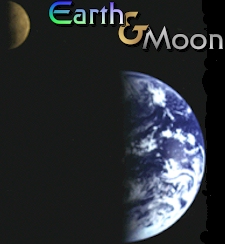Science College, General Science Dept
Mercury 's name comes from the Roman god of commerce, travel and thievery. It was so named because it moves so quickly across the sky.
Mercury is the planet closest to the Sun and the eighth largest of the nine planets. It is covered with craters, much like our Moon, and has changed very little from when it was first formed.
The temperature on Mercury ranges from very hot to very cold. During the day it is so hot that lead would run like water over rocks. At night the temperature is icy cold.
It was once believed that there was no water on Mercury, but this turned out to be false. Recent radar information shows evidence of ice at Mercury's north pole! The ice hasn't melted because it is protected from the Sun's heat by the shadows of some craters.
Mercury has the shortest year in the Solar System and the longest day. The year is 88 days, but sunrise to sunrise takes 176 days.
Although Mercury is the closest planet to the sun, it is not the hottest one.
Mercury has no moons.Venus is the Roman goddess of love and beauty. The planet is so named because it is the brightest of the planets.
Venus is the second planet from the Sun and the sixth largest of all the nine planets.
Venus' surface is very hot - about 400 degrees Celsius! It is the hottest of all the planets in the Solar System. This hot temperature is due to what we call "the Greenhouse Effect." The large amount of carbon dioxide in Venus' atmosphere acts like a blanket. The heat gets trapped underneath the thick layer of clouds. The heat has nowhere to go, so Venus gets hotter and stays hot.
Even though Venus is very cloudy, it's simply *too hot* for rain to form.
Venus has no moons.Earth is the only planet whose English name does not derive from Greek or Roman mythology. The name comes from Old English and Germanic language.
Earth is the third planet from the Sun and the fifth largest of the nine planets.
The Earth is the only planet that has liquid water on its surface. About 71 % of the Earth's surface is covered with water. Water is essential for life as we know it. It allows plants to live and flourish. The plants provide oxygen to the atmosphere, which is vital for animals to survive. The Earth's vast oceans keep temperatures stable - important for life on our planet. Water is also responsible for most of the erosion and weathering of the Earth's continents, a process unique in our solar system.
The Earth's atmosphere is 77% nitrogen, 21% oxygen, with traces of argon, and carbon dioxide. The carbon dioxide in the Earth's atmosphere is very important. Carbon dioxide helps to maintain the Earth's temperature by way of the Greenhouse Effect. The Greenhouse Effect warms the Earth's temperature; without it, the oceans would freeze and life as we know it would be impossible.
The Earth is orbited by one moon. It has no light of its own, but it appears bright in the sky because it reflects the light of the Sun.Mars is the Roman god of war. The planet probably got this name due to its red color. The name of the month March derives from Mars.
Mars is the fourth planet from the Sun and the seventh largest of the nine planets.
Mars is a mysterious planet that has intrigued astronomers for centuries. It is sometimes referred to as the "Red Planet."
Mars has permanent ice caps at both poles made up mostly of solid carbon dioxide. We know this as "dry ice."
The atmosphere on Mars is primarily carbon dioxide. It also has nitrogen, argon and small amounts of other gases. Heavy winds can cause vast dust storms that sometimes blow through the entire planet for months!
Mars has two tiny moons that orbit very close to the surface. Their names are Phobos and Deimos.
Previous | Next




